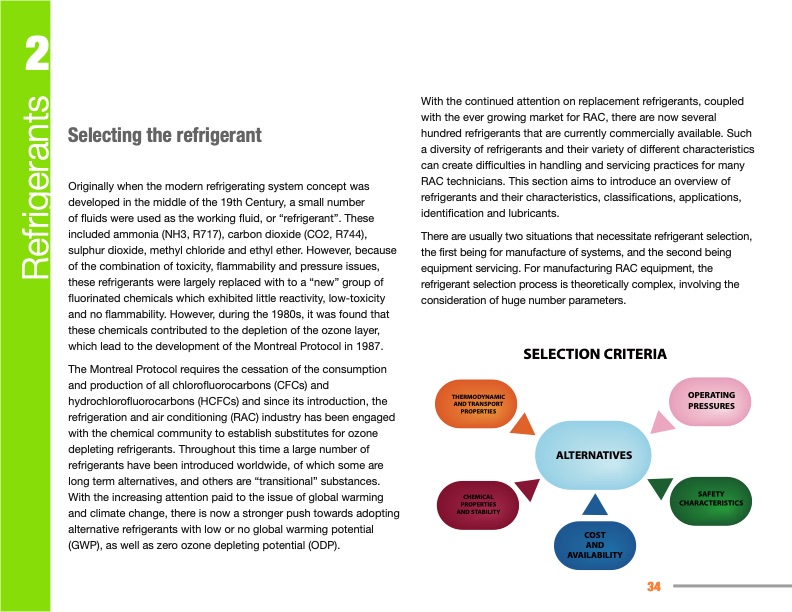
PDF Publication Title:
Text from PDF Page: 034
2 Selecting the refrigerant Originally when the modern refrigerating system concept was developed in the middle of the 19th Century, a small number of fluids were used as the working fluid, or “refrigerant”. These included ammonia (NH3, R717), carbon dioxide (CO2, R744), sulphur dioxide, methyl chloride and ethyl ether. However, because of the combination of toxicity, flammability and pressure issues, these refrigerants were largely replaced with to a “new” group of fluorinated chemicals which exhibited little reactivity, low-toxicity and no flammability. However, during the 1980s, it was found that these chemicals contributed to the depletion of the ozone layer, which lead to the development of the Montreal Protocol in 1987. The Montreal Protocol requires the cessation of the consumption and production of all chlorofluorocarbons (CFCs) and hydrochlorofluorocarbons (HCFCs) and since its introduction, the refrigeration and air conditioning (RAC) industry has been engaged with the chemical community to establish substitutes for ozone depleting refrigerants. Throughout this time a large number of refrigerants have been introduced worldwide, of which some are long term alternatives, and others are “transitional” substances. With the increasing attention paid to the issue of global warming and climate change, there is now a stronger push towards adopting alternative refrigerants with low or no global warming potential (GWP), as well as zero ozone depleting potential (ODP). With the continued attention on replacement refrigerants, coupled with the ever growing market for RAC, there are now several hundred refrigerants that are currently commercially available. Such a diversity of refrigerants and their variety of different characteristics can create difficulties in handling and servicing practices for many RAC technicians. This section aims to introduce an overview of refrigerants and their characteristics, classifications, applications, identification and lubricants. There are usually two situations that necessitate refrigerant selection, the first being for manufacture of systems, and the second being equipment servicing. For manufacturing RAC equipment, the refrigerant selection process is theoretically complex, involving the CHAPITRE 2 consideration of huge number parameters. PAGE 03 THERMODYNAMIC AND TRANSPORT PROPERTIES CHEMICAL PROPERTIES AND STABILITY SELECTION CRITERIA ALTERNATIVES COST AND AVAILABILITY OPERATING PRESSURES SAFETY CHARACTERISTICS 34 RefrigerantsPDF Image | Manual for Refrigeration Servicing Technicians

PDF Search Title:
Manual for Refrigeration Servicing TechniciansOriginal File Name Searched:
Refrigeration_Servicing.pdfDIY PDF Search: Google It | Yahoo | Bing
NFT (Non Fungible Token): Buy our tech, design, development or system NFT and become part of our tech NFT network... More Info
IT XR Project Redstone NFT Available for Sale: NFT for high tech turbine design with one part 3D printed counter-rotating energy turbine. Be part of the future with this NFT. Can be bought and sold but only one design NFT exists. Royalties go to the developer (Infinity) to keep enhancing design and applications... More Info
Infinity Turbine IT XR Project Redstone Design: NFT for sale... NFT for high tech turbine design with one part 3D printed counter-rotating energy turbine. Includes all rights to this turbine design, including license for Fluid Handling Block I and II for the turbine assembly and housing. The NFT includes the blueprints (cad/cam), revenue streams, and all future development of the IT XR Project Redstone... More Info
Infinity Turbine ROT Radial Outflow Turbine 24 Design and Worldwide Rights: NFT for sale... NFT for the ROT 24 energy turbine. Be part of the future with this NFT. This design can be bought and sold but only one design NFT exists. You may manufacture the unit, or get the revenues from its sale from Infinity Turbine. Royalties go to the developer (Infinity) to keep enhancing design and applications... More Info
Infinity Supercritical CO2 10 Liter Extractor Design and Worldwide Rights: The Infinity Supercritical 10L CO2 extractor is for botanical oil extraction, which is rich in terpenes and can produce shelf ready full spectrum oil. With over 5 years of development, this industry leader mature extractor machine has been sold since 2015 and is part of many profitable businesses. The process can also be used for electrowinning, e-waste recycling, and lithium battery recycling, gold mining electronic wastes, precious metals. CO2 can also be used in a reverse fuel cell with nafion to make a gas-to-liquids fuel, such as methanol, ethanol and butanol or ethylene. Supercritical CO2 has also been used for treating nafion to make it more effective catalyst. This NFT is for the purchase of worldwide rights which includes the design. More Info
NFT (Non Fungible Token): Buy our tech, design, development or system NFT and become part of our tech NFT network... More Info
Infinity Turbine Products: Special for this month, any plans are $10,000 for complete Cad/Cam blueprints. License is for one build. Try before you buy a production license. May pay by Bitcoin or other Crypto. Products Page... More Info
| CONTACT TEL: 608-238-6001 Email: greg@infinityturbine.com | RSS | AMP |